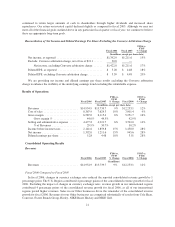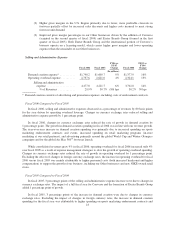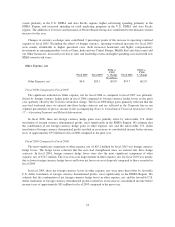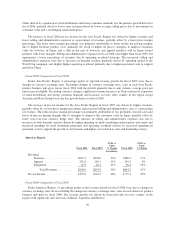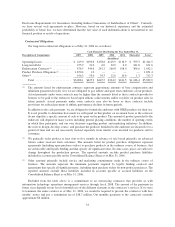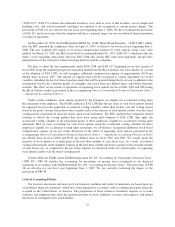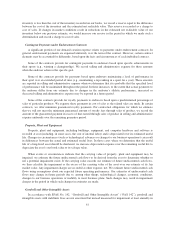Nike 2006 Annual Report Download - page 29
Download and view the complete annual report
Please find page 29 of the 2006 Nike annual report below. You can navigate through the pages in the report by either clicking on the pages listed below, or by using the keyword search tool below to find specific information within the annual report.
The increase in apparel sales for fiscal 2005 was driven by volume increases in branded apparel, partially
offset by a decline in revenue from sales of licensed apparel. The decline in revenue from licensed apparel was
due to the expiration of our license agreement with the NBA, in the second quarter of fiscal 2005, and a shift in
consumer preference towards branded apparel.
For fiscal 2005, higher revenues, an improved gross margin percentage, and slightly lower selling and
administrative expenses as a percentage of revenues drove the U.S. Region pre-tax income increase. The
improved gross margin percentage was primarily the result of fewer, more profitable closeout sales partially
offset by increased sales discounts (the result of increased sales to high volume accounts) and higher costs
incurred to meet strong footwear unit demand. Selling and administrative expenses were higher than fiscal 2004,
but represented a slightly smaller percentage of revenues due to operating overhead leverage. The increase in
selling and administrative costs was due to increases in both demand creation and operating overhead. The
increase in demand creation was primarily driven by increased spending on sports marketing endorsements and
events and increased retail marketing spending. The increase in operating overhead spending was driven by
increased spending on personnel costs and new NIKE-owned retail stores and higher costs related to sales and
leadership events.
EMEA Region
Fiscal 2006 Fiscal 2005
FY06 vs.
FY05
% Change Fiscal 2004
FY05 vs.
FY04
% Change
(In millions)
Revenues
Footwear ................... $2,454.3 $2,500.0 (2)% $2,232.2 12%
Apparel .................... 1,559.0 1,497.1 4% 1,333.8 12%
Equipment .................. 313.3 284.5 10% 261.7 9%
Total Revenues .......... $4,326.6 $4,281.6 1% $3,827.7 12%
Pre-tax Income .................. $ 960.7 $ 917.5 5% $ 744.0 23%
Fiscal 2006 Compared to Fiscal 2005
For the EMEA Region, changes in currency exchange rates reduced revenue growth by 4 percentage points
in fiscal 2006. Excluding changes in currency exchange rates, all three product business units grew. Excluding
currency changes, the increase in footwear revenues reflected increased unit sales partially offset by declines in
the average selling price per pair. The increased unit sales were driven by increased demand for sport culture
products. The declines in the average selling price per pair were due in part to changes in the mix of in-line
products sold towards products with a lower average selling price and higher sales incentives as a result of a
difficult retail environment in Western Europe. The increase in EMEA apparel revenue was driven by increased
unit sales and average selling prices of NIKE branded apparel, primarily increased unit sales of sport
performance products, including soccer products driven by the World Cup, and increased average selling prices
across most apparel categories. Excluding changes in currency exchange rates, sales increases in the emerging
markets of our Central Europe, Middle East and Africa unit led the revenue growth, while sales increases in
Western and Northern Europe also contributed to the EMEA sales growth for fiscal 2006.
The increase in pre-tax income for the EMEA Region for fiscal 2006 was driven by higher revenues and
lower selling and administrative expenses as a percentage of revenues more than offsetting a lower gross margin
percentage and unfavorable foreign currency translation versus fiscal 2005. The lower gross margin percentage
was primarily the result of lower in-line net pricing margins in footwear and apparel, partially offset by improved
year-over-year hedge rates. The lower in-line net pricing margins for footwear were due to higher product costs,
primarily the result of higher oil prices, higher sales incentives, strategies to improve consumer value, and a shift
in the mix of products sold towards products with lower margins. The reduced in-line net pricing margins for
28





